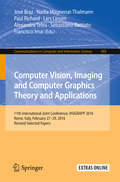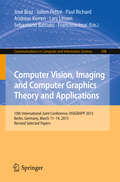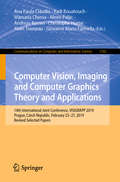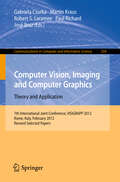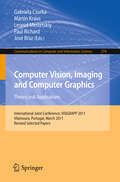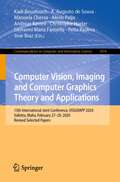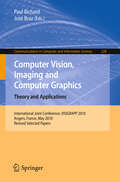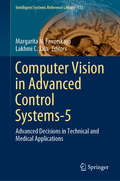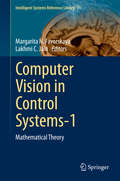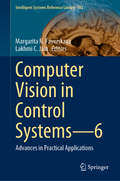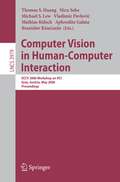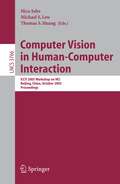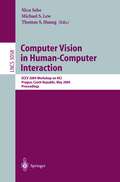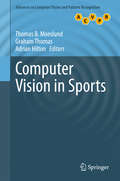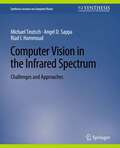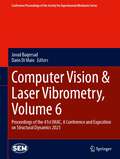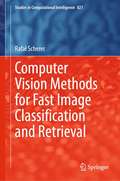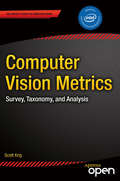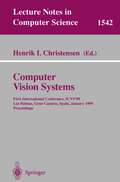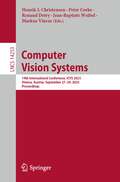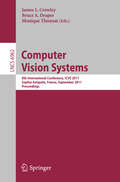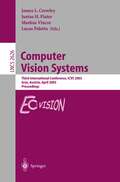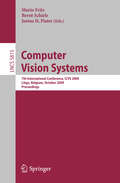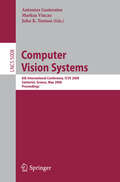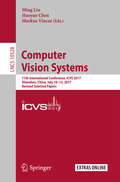- Table View
- List View
Computer Vision, Imaging and Computer Graphics Theory and Applications: 11th International Joint Conference, VISIGRAPP 2016, Rome, Italy, February 27 – 29, 2016, Revised Selected Papers (Communications in Computer and Information Science #693)
by José Braz Nadia Magnenat-Thalmann Paul Richard Lars Linsen Alexandru Telea Sebastiano Battiato Francisco ImaiThis book constitutes thoroughly revised and selected papers from the 11th International Joint Conference on Computer Vision, Imaging and Computer Graphics Theory and Applications, VISIGRAPP 2016, held in Rome, Italy, in February 2016. VISIGRAPP comprises GRAPP, International Conference on Computer Graphics Theory and Applications; IVAPP, International Conference on Information Visualization Theory and Applications; and VISAPP, International Conference on Computer Vision Theory and Applications. The 28 thoroughly revised and extended papers presented in this volume were carefully reviewed and selected from 338 submissions. The book also contains one invited talk in full-paper length. The regular papers were organized in topical sections named: computer graphics theory and applications; information visualization theory and applications; and computer vision theory and applications.
Computer Vision, Imaging and Computer Graphics Theory and Applications: 10th International Joint Conference, VISIGRAPP 2015, Berlin, Germany, March 11-14, 2015, Revised Selected Papers (Communications in Computer and Information Science #598)
by José Braz Julien Pettré Paul Richard Andreas Kerren Lars Linsen Sebastiano Battiato Francisco ImaiThis book constitutes thoroughly revised and selected papers from the 10th International Joint Conference on Computer Vision, Imaging and Computer Graphics Theory and Applications, VISIGRAPP 2015, held in Berlin, Germany, in March 2015. VISIGRAPP comprises GRAPP, International Conference on Computer Graphics Theory and Applications; IVAPP, International Conference on Information Visualization Theory and Applications; and VISAPP, International Conference on Computer Vision Theory and Applications. The 23 thoroughly revised and extended papers presented in this volume were carefully reviewed and selected from 529 submissions. The book also contains one invited talk in full-paper length. The regular papers were organized in topical sections named: computer graphics theory and applications; information visualization theory and applications; and computer vision theory and applications.
Computer Vision, Imaging and Computer Graphics Theory and Applications: 14th International Joint Conference, VISIGRAPP 2019, Prague, Czech Republic, February 25–27, 2019, Revised Selected Papers (Communications in Computer and Information Science #1182)
by Ana Paula Cláudio Kadi Bouatouch Manuela Chessa Alexis Paljic Andreas Kerren Christophe Hurter Alain Tremeau Giovanni Maria FarinellaThis book constitutes thoroughly revised and selected papers from the 14th International Joint Conference on Computer Vision, Imaging and Computer Graphics Theory and Applications, VISIGRAPP 2019, held in Prague, Czech Republic, in February 2019. The 25 thoroughly revised and extended papers presented in this volume were carefully reviewed and selected from 395 submissions. The papers contribute to the understanding of relevant trends of current research on computer graphics; human computer interaction; information visualization; computer vision.
Computer Vision, Imaging and Computer Graphics - Theory and Applications: International Joint Conference, VISIGRAPP 2012, Rome, Italy, February 24-26, 2012. Revised Selected Papers (Communications in Computer and Information Science #359)
by Gabriela Csurka José Braz Martin Kraus Robert S. Laramee Paul RichardThis book constitutes the refereed proceedings of the International Conference, VISIGRAPP 2012, the Joint Conference on Computer Vision Theory and Applications (VISAPP), on Computer Graphics Theory and Applications (GRAPP), and on Information Visualization Theory and Applications (IVAPP), held in Rome, Italy, in February 2012. The 28 revised full papers presented together with one invited paper were carefully reviewed and selected from 483 submissions. The papers are organized in topical sections on computer graphics theory and applications; information visualization theory and applications; computer vision theory and applications.
Computer Vision, Imaging and Computer Graphics - Theory and Applications: International Joint Conference, VISIGRAPP 2011, Vilamoura, Portugal, March 5-7, 2011. Revised Selected Papers (Communications in Computer and Information Science #274)
by Gabriela Csurka José Braz Martin Kraus Leonid Mestetskiy Paul RichardThis book constitutes the refereed proceedings of the International Conference, VISIGRAPP 2011, the Joint Conference on Computer Vision, Theory and Applications (VISAPP), on Imaging Theory and Applications (IMAGAPP), on Computer Graphics Theory and Applications (GRAPP), and on Information Visualization Theory and Applications (IVAPP), held in Vilamoura, Portugal, in March 2011. The 15 revised full papers presented together with one invited paper were carefully reviewed and selected. The papers are organized in topical sections on computer graphics theory and applications; imaging theory and applications; information visualization theory and applications; and computer vision theory and applications.
Computer Vision, Imaging and Computer Graphics Theory and Applications: 15th International Joint Conference, VISIGRAPP 2020 Valletta, Malta, February 27–29, 2020, Revised Selected Papers (Communications in Computer and Information Science #1474)
by Petia Radeva Giovanni Maria Farinella Andreas Kerren Christophe Hurter Manuela Chessa Kadi Bouatouch Alexis Paljic A. Augusto de Sousa Jose BrazThis book constitutes thoroughly revised and selected papers from the 15th International Joint Conference on Computer Vision, Imaging and Computer Graphics Theory and Applications, VISIGRAPP 2020, held in Valletta, Malta, in February 2020.The 25 thoroughly revised and extended papers presented in this volume were carefully reviewed and selected from 455 submissions. The papers contribute to the understanding of relevant trends of current research on computer graphics; human computer interaction; information visualization; computer vision.
Computer Vision, Imaging and Computer Graphics. Theory and Applications: International Joint Conference, VISIGRAPP 2010, Angers, France, May 17-21, 2010. Revised Selected Papers (Communications in Computer and Information Science #229)
by Paul Richard José BrazThis book constitutes the refereed proceedings of the International Conference, VISIGRAPP 2010, the Joint Conference on Computer Vision Theory and Applications (VISAPP), on Imaging Theory and Applications (IMAGAPP), and on Computer Graphics Theory and Applications (GRAPP), held in Angers, France, in May 2010. The 19 revised full papers presented together with two invited papers were carefully reviewed and selected. The papers are organized in topical sections on computer vision theory and applications; imaging theory and applications; computer graphics theory and applications; and information visualization theory and applications.
Computer Vision in Advanced Control Systems-5: Advanced Decisions in Technical and Medical Applications (Intelligent Systems Reference Library #175)
by Margarita N. Favorskaya Lakhmi C. JainThis book applies novel theories to improve algorithms in complex data analysis in various fields, including object detection, remote sensing, data transmission, data fusion, gesture recognition, and medical image processing and analysis. It is intended for Ph.D. students, academics, researchers, and software developers working in the areas of digital video processing and computer vision technologies.
Computer Vision in Control Systems-1: Mathematical Theory (Intelligent Systems Reference Library #73)
by Margarita N. Favorskaya Lakhmi C. JainThis book is focused on the recent advances in computer vision methodologies and technical solutions using conventional and intelligent paradigms. The Contributions include:· Morphological Image Analysis for Computer Vision Applications.· Methods for Detecting of Structural Changes in Computer Vision Systems.· Hierarchical Adaptive KL-based Transform: Algorithms and Applications.· Automatic Estimation for Parameters of Image Projective Transforms Based on Object-invariant Cores.· A Way of Energy Analysis for Image and Video Sequence Processing.· Optimal Measurement of Visual Motion Across Spatial and Temporal Scales.· Scene Analysis Using Morphological Mathematics and Fuzzy Logic.· Digital Video Stabilization in Static and Dynamic Scenes.· Implementation of Hadamard Matrices for Image Processing.· A Generalized Criterion of Efficiency for Telecommunication Systems.The book is directed to PhD students, professors, researchers and software developers working in the areas of digital video processing and computer vision technologies.
Computer Vision in Control Systems—6: Advances in Practical Applications (Intelligent Systems Reference Library #182)
by Margarita N. Favorskaya Lakhmi C. JainThis book attempts to improve algorithms by novel theories and complex data analysis in different scopes including object detection, remote sensing, data transmission, data fusion, gesture recognition, and edical image processing and analysis.The book is directed to the Ph.D. students, professors, researchers, and software developers working in the areas of digital video processing and computer vision technologies.
Computer Vision in Human-Computer Interaction: ECCV 2006 Workshop on HCI, Graz, Austria, May 13, 2006, Proceedings (Lecture Notes in Computer Science #3979)
by Thomas S. Huang Nicu Sebe Michael S. Lew Vladimir Pavlovic Mathias Kölsch Aphrodite Galata Branislav KisacaninThis book constitutes the refereed proceedings of the International Workshop on Human-Computer Interaction, HCI/ECCV 2006. The 11 revised full papers presented were carefully reviewed and selected from 27 submissions. The papers address a wide range of theoretical and application issues in human-computer interaction ranging from face analysis, gesture and emotion recognition, and event detection to various applications in those fields.
Computer Vision in Human-Computer Interaction: ICCV 2005 Workshop on HCI, Beijing, China, October 21, 2005, Proceedings (Lecture Notes in Computer Science #3766)
by Nicu Sebe Michael S. Lew Thomas S. HuangHuman-Computer Interaction (HCI) lies at the crossroads of many scienti?c areas including arti?cial intelligence, computer vision, face recognition, motion tracking, etc. In order for HCI systems to interact seamlessly with people, they need to understand their environment through vision and auditory input. Mo- over, HCI systems should learn how to adaptively respond depending on the situation. The goal of this workshop was to bring together researchers from the ?eld of computer vision whose work is related to human-computer interaction. The selected articles for this workshop address a wide range of theoretical and - plication issues in human-computer interaction ranging from human-robot - teraction, gesture recognition, and body tracking, to facial features analysis and human-computer interaction systems. This year 74 papers from 18 countries were submitted and 22 were accepted for presentation at the workshop after being reviewed by at least 3 members of the Program Committee. We had therefore a very competitive acceptance rate of less than 30% and as a consequence we had a very-high-quality workshop. Wewouldliketo thankallmembersofthe ProgramCommitteefor their help in ensuring the quality of the papers accepted for publication. We are grateful to Dr. Jian Wang for giving the keynote address. In addition, we wish to thank the organizers of the 10th IEEE International Conference on Computer Vision and our sponsors, University of Amsterdam, Leiden Institute of Advanced Computer Science, and the University of Illinois at Urbana-Champaign, for support in setting up our workshop.
Computer Vision in Human-Computer Interaction: ECCV 2004 Workshop on HCI, Prague, Czech Republic, May 16, 2004, Proceedings (Lecture Notes in Computer Science #3058)
by Nicu Sebe Michael S. Lew Thomas S. HuangThis book constitutes the refereed proceedings of the International Workshop on Human-Computer Interaction, HCI 2004, held at ECCV 2004 in Prague, Czech Republic in May 2004. The 19 revised full papers presented together with an introductory overview and an invited paper were carefully reviewed and selected from 45 submissions. The papers are organized in topical sections on human-robot interaction, gesture recognition and body tracking, systems, and face and head.
Computer Vision in Sports (Advances in Computer Vision and Pattern Recognition)
by Thomas B. Moeslund Graham Thomas Adrian HiltonThe first book of its kind devoted to this topic, this comprehensive text/reference presents state-of-the-art research and reviews current challenges in the application of computer vision to problems in sports. Opening with a detailed introduction to the use of computer vision across the entire life-cycle of a sports event, the text then progresses to examine cutting-edge techniques for tracking the ball, obtaining the whereabouts and pose of the players, and identifying the sport being played from video footage. The work concludes by investigating a selection of systems for the automatic analysis and classification of sports play. The insights provided by this pioneering collection will be of great interest to researchers and practitioners involved in computer vision, sports analysis and media production.
Computer Vision in the Infrared Spectrum: Challenges and Approaches (Synthesis Lectures on Computer Vision)
by Michael Teutsch Angel D. Sappa Riad I. HammoudHuman visual perception is limited to the visual-optical spectrum. Machine vision is not. Cameras sensitive to the different infrared spectra can enhance the abilities of autonomous systems and visually perceive the environment in a holistic way. Relevant scene content can be made visible especially in situations, where sensors of other modalities face issues like a visual-optical camera that needs a source of illumination. As a consequence, not only human mistakes can be avoided by increasing the level of automation, but also machine-induced errors can be reduced that, for example, could make a self-driving car crash into a pedestrian under difficult illumination conditions. Furthermore, multi-spectral sensor systems with infrared imagery as one modality are a rich source of information and can provably increase the robustness of many autonomous systems. Applications that can benefit from utilizing infrared imagery range from robotics to automotive and from biometrics to surveillance. In this book, we provide a brief yet concise introduction to the current state-of-the-art of computer vision and machine learning in the infrared spectrum. Based on various popular computer vision tasks such as image enhancement, object detection, or object tracking, we first motivate each task starting from established literature in the visual-optical spectrum. Then, we discuss the differences between processing images and videos in the visual-optical spectrum and the various infrared spectra. An overview of the current literature is provided together with an outlook for each task. Furthermore, available and annotated public datasets and common evaluation methods and metrics are presented. In a separate chapter, popular applications that can greatly benefit from the use of infrared imagery as a data source are presented and discussed. Among them are automatic target recognition, video surveillance, or biometrics including face recognition. Finally, we conclude with recommendations for well-fitting sensor setups and data processing algorithms for certain computer vision tasks. We address this book to prospective researchers and engineers new to the field but also to anyone who wants to get introduced to the challenges and the approaches of computer vision using infrared images or videos. Readers will be able to start their work directly after reading the book supported by a highly comprehensive backlog of recent and relevant literature as well as related infrared datasets including existing evaluation frameworks. Together with consistently decreasing costs for infrared cameras, new fields of application appear and make computer vision in the infrared spectrum a great opportunity to face nowadays scientific and engineering challenges.
Computer Vision & Laser Vibrometry, Volume 6: Proceedings of the 41st IMAC, A Conference and Exposition on Structural Dynamics 2023 (Conference Proceedings of the Society for Experimental Mechanics Series)
by Javad Baqersad Dario Di MaioComputer Vision & Laser Vibrometry, Volume 6: Proceedings of the 41st IMAC, A Conference and Exposition on Structural Dynamics, 2023, the sixth volume of ten from the Conference brings together contributions to this important area of research and engineering. The collection presents early findings and case studies on fundamental and applied aspects of Computer Vision, Laser Vibrometry and Structural Health Monitoring, including papers on:Novel TechniquesOptical Methods,Scanning LDV MethodsPhotogrammetry & DICStructural Health Monitoring
Computer Vision Methods for Fast Image Classification and Retrieval (Studies in Computational Intelligence #821)
by Rafał SchererThe book presents selected methods for accelerating image retrieval and classification in large collections of images using what are referred to as ‘hand-crafted features.’ It introduces readers to novel rapid image description methods based on local and global features, as well as several techniques for comparing images.Developing content-based image comparison, retrieval and classification methods that simulate human visual perception is an arduous and complex process. The book’s main focus is on the application of these methods in a relational database context. The methods presented are suitable for both general-type and medical images. Offering a valuable textbook for upper-level undergraduate or graduate-level courses on computer science or engineering, as well as a guide for computer vision researchers, the book focuses on techniques that work under real-world large-dataset conditions.
Computer Vision Metrics: Survey, Taxonomy, and Analysis
by Scott KrigComputer Vision Metrics provides an extensive survey and analysis of over 100 current and historical feature description and machine vision methods, with a detailed taxonomy for local, regional and global features. This book provides necessary background to develop intuition about why interest point detectors and feature descriptors actually work, how they are designed, with observations about tuning the methods for achieving robustness and invariance targets for specific applications. The survey is broader than it is deep, with over 540 references provided to dig deeper. The taxonomy includes search methods, spectra components, descriptor representation, shape, distance functions, accuracy, efficiency, robustness and invariance attributes, and more. Rather than providing ‘how-to’ source code examples and shortcuts, this book provides a counterpoint discussion to the many fine opencv community source code resources available for hands-on practitioners.
Computer Vision Systems: First International Conference, ICVS '99 Las Palmas, Gran Canaria, Spain, January 13-15, 1999 Proceedings (Lecture Notes in Computer Science #1542)
by Henrik I. ChristensenComputer Vision has now reached a level of maturity that allows us not only to perform research on individual methods but also to build fully integrated computer vision systems of a signi cant complexity. This opens up a number of new problems related to architectures, systems integration, validation of - stems using benchmarking techniques, and so on. So far, the majority of vision conferences have focused on component technologies, which has motivated the organization of the First International Conference on Computer Vision Systems (ICVS). It is our hope that the conference will allow us not only to see a number of interesting new vision techniques and systems but hopefully also to de ne the research issues that need to be addressed to pave the way for more wide-scale use of computer vision in a diverse set of real-world applications. ICVS is organized as a single-track conference consisting of high-quality, p- viously unpublished, contributed papers on new and original research on c- puter vision systems. All contributions will be presented orally. A total of 65 papers were submitted for consideration by the conference. All papers were - viewed by three reviewers from the program committee. Thirty-two of the papers were selected for presentation. ICVS’99 is being held at the Alfredo Kraus Auditorium and Convention Centre, in Las Palmas, on the lovely Canary Islands, Spain. The setting is spri- like, which seems only appropriate as the basis for a new conference.
Computer Vision Systems: 14th International Conference, ICVS 2023, Vienna, Austria, September 27–29, 2023, Proceedings (Lecture Notes in Computer Science #14253)
by Henrik I. Christensen Peter Corke Renaud Detry Jean-Baptiste Weibel Markus VinczeThis volume LNCS 14253 constitutes the refereed proceedings of the 14th International Conference, ICVS 2023, in Vienna, Austria, in September 2023.. The 37 full papers presented were carefully reviewed and selected from 74 submissions. The conference focuses on Humans and Hands; Medical and Health Care; Farming and Forestry; Automation and Manufacturing; Mobile Robotics and Autonomous Systems; and Performance and Robustness.
Computer Vision Systems: 8th International Conference, ICVS 2011, Sophia Antipolis, France, September 20-22, 2011, Proceedings (Lecture Notes in Computer Science #6962)
by James L. Crowley Bruce Draper Monique ThonnatThis book constitutes the refereed proceedings of the 8th International Conference on Computer Vision Systems, ICVS 2011, held in Sophia Antipolis, France, in September 2009. The 22 revised papers presented were carefully reviewed and selected from 58 submissions. The papers are organized in topical sections on vision systems, control of perception, performance evaluation, activity recognition, and knowledge directed vision.
Computer Vision Systems: Third International Conference, ICVS 2003, Graz, Austria, April 1-3, 2003, Proceedings (Lecture Notes in Computer Science #2626)
by James Crowley Justus Piater Markus Vincze Lucas PalettaThis book constitutes the refereed proceedings of the Third International Conference on Computer Vision Systems, ICVS 2003, held in Graz, Austria, in April 2003. The 51 revised full papers presented were carefully reviewed and selected from 109 submissions. The papers are organized in topical sections on cognitive vision, philosophical issues in cognitive vision, cognitive vision and applications, computer vision architectures, performance evaluation, implementation methods, architecture and classical computer vision, and video annotation.
Computer Vision Systems: 7th International Conference on Computer Vision Systems, ICVS 2009 Liège, Belgium, October 13-15, 2009, Proceedings (Lecture Notes in Computer Science #5815)
by Mario Fritz Bernt Schiele Justus H. PiaterThis book constitutes the refereed proceedings of the 7th International Conference on Computer Vision Systems, ICVS 2009, held in Liege, Belgium, October 13-15, 2009. The 21 papers for oral presentation presented together with 24 poster presentations and 2 invited papers were carefully reviewed and selected from 96 submissions. The papers are organized in topical sections on human-machine-interaction, sensors, features and representations, stereo, 3D and optical flow, calibration and registration, mobile and autonomous systems, evaluation, studies and applications, learning, recognition and adaption.
Computer Vision Systems: 6th International Conference on Computer Vision Systems, ICVS 2008 Santorini, Greece, May 12-15, 2008, Proceedings (Lecture Notes in Computer Science #5008)
by Antonios Gasteratos Markus Vincze John K. TsotsosIn the past few years, with the advances in microelectronics and digital te- nology, cameras became a widespread media. This, along with the enduring increase in computing power boosted the development of computer vision s- tems. The International Conference on Computer Vision Systems (ICVS) covers the advances in this area. This is to say that ICVS is not and should not be yet another computer vision conference. The ?eld of computer vision is fully covered by many well-established and famous conferences and ICVS di?ers from these by covering the systems point of view. ICVS 2008 was the 6th International Conference dedicated to advanced research on computer vision systems. The conference, continuing a series of successful events in Las Palmas, Vancouver, Graz, New York and Bielefeld, in 2008 was held on Santorini. In all, 128 papers entered the review process and each was reviewed by three independent reviewers using the double-blind review method. Of these, 53 - pers were accepted (23 as oral and 30 as poster presentation). There were also two invited talks by P. Anandan and by Heinrich H. Bultho ¨ ?. The presented papers cover all aspects of computer vision systems, namely: cognitive vision, monitor and surveillance, computer vision architectures, calibration and reg- tration, object recognition and tracking, learning, human—machine interaction and cross-modal systems.
Computer Vision Systems: 11th International Conference, ICVS 2017, Shenzhen, China, July 10-13, 2017, Revised Selected Papers (Lecture Notes in Computer Science #10528)
by Ming Liu Haoyao Chen Markus VinczeThis book constitutes the refereed proceedings of the 11th International Conference on Computer Vision Systems, ICVS 2017, held in Shenzhen, China, in July 2017. The 61 papers presented were carefully reviewed and selected from 92 submissions. The papers are organized in topical sections on visual control, visual navigation, visual inspection, image processing, human robot interaction, stereo system, image retrieval, visual detection, visual recognition, system design, and 3D vision / fusion.
